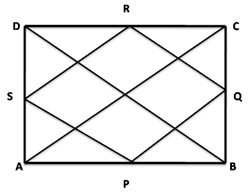Show that the quadrilateral formed by joining the midpoints of the pairs of adjacent sides of a rectangle is a rhombus.
Let ABCD be the rectangle and P, Q, R and S be the midpoints of AB, BC, CD and DA, respectively.

Join diagonals of the rectangle.
In ∆ ABC, we have, by midpoint theorem,
∴ PQ ∣∣ AC and PQ = ![]() AC
AC
Similarly, SR ∣∣ AC and SR =![]() AC.
AC.
As, PQ ∣∣ AC and SR ∣∣ AC, then also PQ ∣∣ SR
Also, PQ = SR, each equal to ![]() AC …(1)
AC …(1)
So, PQRS is a parallelogram
Now, in ∆SAP and ∆QBP, we have,
AS = BQ
∠A = ∠B = 90°
AP = BP
∴ By SAS test of congruency,
∆SAP ≅ ∆QBP
Hence, PS = PQ …by cpct …(2)
Similarly, ∆SDR ≅ ∆QCR
∴ SR = RQ … by cpct …(3)
Hence, from 1, 2 and 3 we have,
PQ = PQ = SR = RQ
Hence, PQRS is a rhombus.
Hence, the quadrilateral formed by joining the midpoints of the pairs of adjacent sides of a rectangle is a rhombus.